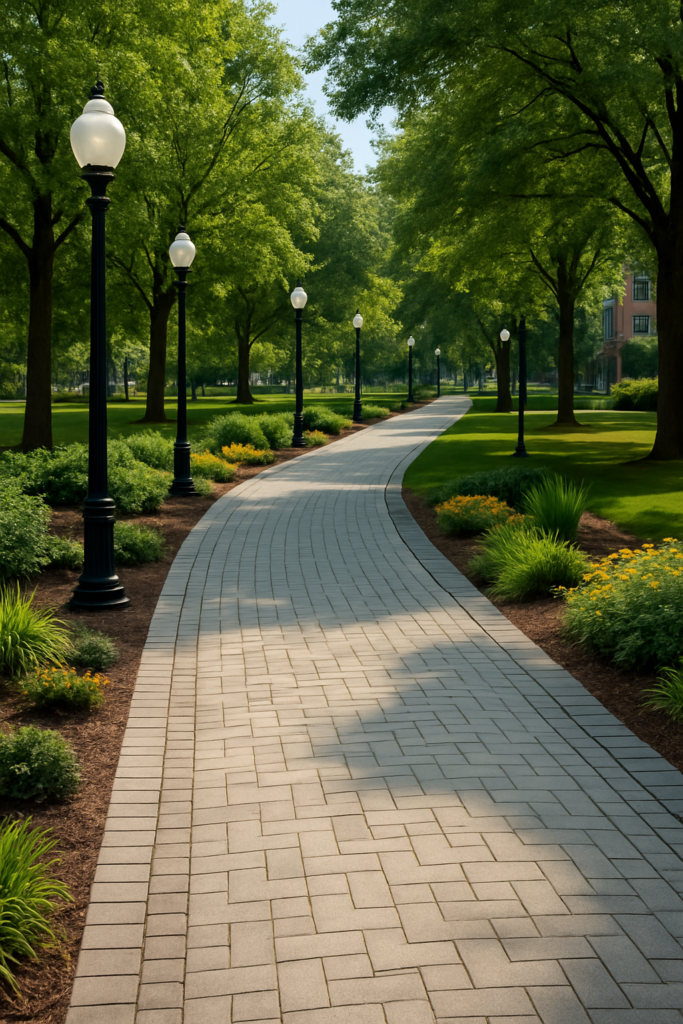Creating a beautiful landscape isn’t just about aesthetic appeal—it’s also a key component of public safety and accessibility. In public parks, plazas, campuses, and civic spaces, thoughtfully designed walkways enhance visibility, reduce accidents, and improve wayfinding. When beauty meets functionality, landscapes can protect as much as they please.
This article outlines how safe, visually engaging walkways can transform public areas, integrating landscape design architecture principles, sustainable strategies, and professional insight.
Why Walkways Are Essential for Safe, Beautiful Landscapes
Guiding Movement and Reducing Risk
Walkways define circulation, keeping pedestrians on designated paths and away from hazards like uneven ground, water features, or vehicular zones.
Increasing Accessibility
ADA-compliant paths ensure inclusivity for individuals of all ages and mobility levels. Safe slopes, tactile surfaces, and ample width make public spaces usable for everyone.
Enhancing Surveillance and Lighting
Clear, open walkways allow for natural surveillance and are easier to light, deterring crime and increasing visibility after dark.
Design Principles for Safe Landscape Walkways
Begin with a Comprehensive Landscape Drawing
Effective walkway design starts with a clear, detailed landscape drawing. This plan maps out grades, path widths, surface materials, adjacent vegetation, and lighting elements to ensure coherence and safety.
Use Non-Slip, Durable Materials
Select paving materials like textured concrete, permeable pavers, or flagstone with anti-slip finishes. These reduce risk during rain or snow while supporting beautiful landscape sustainability through drainage.
Define Edges and Guide Movement
Use contrasting materials, plant borders, or low lighting to mark walkway boundaries. This improves visual guidance and supports safe navigation.
Incorporate Rest Stops and Visibility
Integrate seating zones and lighting every 100 to 150 feet in long walkways. These features aid comfort, visibility, and safety.
Landscape Design Architecture That Supports Safety
Natural Surveillance
Position walkways to be visible from nearby buildings, streets, or security stations. Keep plantings trimmed below sight lines and avoid dense hedges that obstruct views.
Lighting Integration
Install energy-efficient LED or solar lighting that illuminates the path evenly without harsh glare. Accent lighting can also enhance beauty while boosting safety.
Learn more in Beautiful Landscape Art Integration for Corporate Identity for incorporating lighting with sculptural and visual elements.
Wayfinding Elements
Incorporate signage, unique plantings, or decorative markers to help users navigate comfortably and confidently.
Sustainable and Safe Walkway Enhancements
Permeable Paving
Reduces runoff, prevents puddling, and minimizes slip hazards. It also supports long-term environmental resilience.
Shade Structures and Tree Canopies
Planting trees or installing pergolas along walkways offers UV protection and reduces heat exposure during warmer months.
Rain Gardens and Green Buffers
Channel stormwater safely away from walkways and toward bioswales or rain gardens. These reduce erosion and flooding while beautifying the environment.
Explore broader integration strategies in Beautiful Landscape for Parks and Public Plazas.
Creating Inviting Resting Spaces Along Walkways
Benches, Alcoves, and Gathering Points
Design quiet areas near walkways for rest or interaction. These spots improve user comfort and attract longer visits to public spaces.
Shaded Nooks and Tables
Encourage relaxation or casual work in outdoor settings. Pair with greenery or art to provide a rich sensory experience.
See examples in Beautiful Landscape Seating Areas for Relaxed Breaks.
Integrating with Multi-Building Campus Design
Safe walkways are crucial for multi-building properties, guiding employees and guests while ensuring security and accessibility across expansive areas.
- Use consistent materials and lighting for uniformity
- Plan direct routes between high-use zones like entrances, parking, and public amenities
- Include signage and maps at key junctions
Explore layout coordination in Beautiful Landscape Layouts for Multi-Building Campuses.
The Role of Professional Landscape Contractors
Safety-First Planning
Experienced landscape contractors identify elevation hazards, drainage concerns, and visibility issues that affect walkway safety.
ADA Compliance and Code Adherence
Contractors ensure pathways meet local and federal accessibility requirements, reducing liability and ensuring inclusiveness.
Long-Term Maintenance Planning
Well-maintained walkways prevent cracks, weeds, and surface erosion. Contractors help develop annual or seasonal care schedules.
Final Thoughts
A beautiful landscape walkway is not just a path—it’s a promise of safety, inclusivity, and environmental care. Through thoughtful landscape design, expert planning, and strategic landscape drawing, public spaces can become safer, more welcoming places for all.
By working with trusted landscape contractors, aligning with sustainability goals, and integrating design best practices, communities can enjoy walkways that inspire movement while preserving security and dignity for every visitor.

